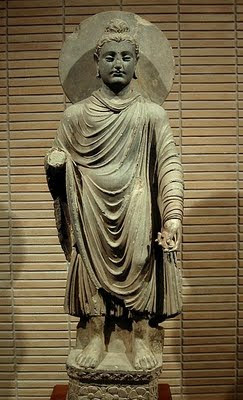Eurocentric Cultural Nationalism
Cultural nationalism is on the rise in Europe, as was shown last week by events in Switzerland and England. At present this movement takes the form of rejection of Islam and rebellion against the forced imposition of Islamic culture on Europe, which is regarded by many Europeans assupremacist, predatory, subversive, barbaric and implacably hostile. This loathing of Islam isn't nowadays just confined to football hooligans, but is gaining increasing support among the 'chattering classes', including the secular humanists.
Cultural nationalists at present regard Islam as public enemy number one, however we must be aware that this targetedIslamophobia may eventually spill over to become a more general Eurocentric cultural xenophobia, with even the growth of Buddhism in Europe being resented as a cultural encroachment.

So maybe the time has come to stress the shared values, civilization and history of Buddhist and European cultures going back over 2000 years to the Hellenistic period (roughly 323BC to 10AD) . Hellenistic civilization followed in the wake of Alexander the Great, extending from the Ancient Greek world to Southwest Asia as far as modern Afghanistan and Pakistan, which formed the culturally brilliant civilisation ofGandhara
Menander (Milinda) was Gandhara's most famous king. He ruled from Taxila and later from Sagala (Sialkot). He became a Buddhist and is remembered for his discussions on emptiness with a great Buddhist philosopher, Nāgasena. FromGandhara many missionaries went out to spread Buddhism to China, Korea, Japan along the Silk Road.

Cutural exchange
There was contact, communication and mutual influence between Greek and Buddhist philosophers. According to the Edicts of Ashoka, set in stone, some of them written in Greek, he sent Buddhist emissaries to the Greek lands in Asia and as far as the Mediterranean.
Buddhism prospered under the Indo-Greek kings, and it has been suggested that their invasion of India was intended to protect the Buddhist faith from the religious persecutions of the new Indian dynasty of the Sungas (185–73 BCE) which had overthrown the Mauryans.

Although the philosophical systems of Buddhism and Christianity have evolved in rather different ways, the moral precepts advocated by Buddhism from the time of Ashokathrough his edicts do have some similarities with the Christian moral precepts developed more than two centuries later: respect for life, respect for the weak, rejection of violence, pardon to sinners, tolerance.

Buddhism and Christianity
One theory is that these similarities may indicate the propagation of Buddhist ideals into the Western World, with the Greeks acting as intermediaries and religious syncretists.
Scholars have often considered the possibility that Buddhism influenced the early development of Christianity.
Early 3rd-4th century Christian writers such as Hippolytusand Epiphanius write about a Scythianus, who visited India around 50 AD from where he brought "the doctrine of the Two Principles". According to these writers, Scythianus' pupilTerebinthus presented himself as a "Buddha". Terebinthuswent to Palestine and Judaea where he met the Apostles ("becoming known and condemned" Isaia), and ultimately settled in Babylon, where he transmitted his teachings to Mani, thereby creating the foundation of what could be called Persian syncretic Buddhism, Manicheism. One of the greatest thinkers and saints of western Christianity, Augustine of Hippo was originally a Manichean.
In the 2nd century CE, the Christian dogmatist Clement of Alexandria recognized Bactrian Buddhists (Sramanas) and Indian Gymnosophists for their influence on Greek thought:
"Thus philosophy, a thing of the highest utility, flourished in antiquity among the barbarians, shedding its light over the nations. And afterwards it came to Greece. First in its ranks were the prophets of the Egyptians; and the Chaldeansamong the Assyrians; and the Druids among the Gauls; and the Sramanas among the Bactrians ("Σαρμαναίοι Βάκτρων"); and the philosophers of the Celts; and the Magi of the Persians, who foretold the Saviour's birth, and came into the land of Judaea guided by a star. The Indian gymnosophistsare also in the number, and the other barbarian philosophers. And of these there are two classes, some of them called Sramanas ("Σαρμάναι"), and others Brahmins("Βραφμαναι")." (Clement of Alexandria "The Stromata, or Miscellanies"
The main Greek cities of the Middle-East happen to have played a key role in the development of Christianity, such as Antioch and especially Alexandria, and "it was later in this very place that some of the most active centers of Christianity were established" (Robert Linssen, "Zen living").
Artistic influences

Although there is still some debate, the first anthropomorphic representations of the Buddha himself are often considered a result of the Greco-Buddhist interaction. Before this innovation, Buddhist art was "aniconic": the Buddha was only represented through his symbols (an empty throne, the Bodhitree, the Buddha's footprints, the Dharma wheel).

This reluctance towards anthropomorphic representations of the Buddha, and the sophisticated development of aniconicsymbols to avoid it (even in narrative scenes where other human figures would appear), seem to be connected to one of the Buddha’s sayings, reported in the Digha Nikaya, that discouraged representations of himself after the extinction of his body.
Probably not feeling bound by these restrictions, and because of their cult of form, the Greeks were the first to attempt a sculptural representation of the Buddha.

Enlightenment values
Buddhist and European civilizations spent their formative years immersed in Hellenistic culture, from which they derive their shared values in art, philosophy, humanism, rationalism and love of learning. The commonality of these values needs to be emphasised and defended as both traditions come under attack from the growing forces of Jihadist barbarism.
 Source: Transcultural Buddhism
Source: Transcultural Buddhism



No comments:
Post a Comment